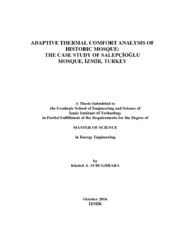Please use this identifier to cite or link to this item:
https://hdl.handle.net/11147/5723Full metadata record
| DC Field | Value | Language |
|---|---|---|
| dc.contributor.advisor | Durmuş Arsan, Zeynep | - |
| dc.contributor.advisor | Gökçen Akkurt, Gülden | - |
| dc.contributor.author | Bughrara, Khaled S. M. | - |
| dc.date.accessioned | 2017-06-08T10:50:39Z | - |
| dc.date.available | 2017-06-08T10:50:39Z | - |
| dc.date.issued | 2016-10 | - |
| dc.identifier.citation | Bughrara, K. S. M. (2016). Adaptive thermal comfort analysis of historic mosque: The case study of Salepçioğlu Mosque, İzmir, Turkey | en_US |
| dc.identifier.uri | http://hdl.handle.net/11147/5723 | - |
| dc.description | Thesis (Master)--Izmir Institute of Technology, Energy Engineering, Izmir, 2016 | en_US |
| dc.description | Full text release delayed at author's request until 2018.11.23 | en_US |
| dc.description | Includes bibliographical references (leaves 90-92) | en_US |
| dc.description | Text in English; Abstract: Turkish and English | en_US |
| dc.description | xv, 106 leaves | en_US |
| dc.description.abstract | Mosques differ from other types of buildings by having intermittent operation schedule. Due to five prayer times per day throughout the year, mosques are fully or partially, yet periodically, occupied. Historic mosques, possessing cultural heritage value, need to be evaluated in terms of thermal comfort. The adaptive thermal comfort method presented by ASHRAE 55 is recommended to be used to analyze thermal comfort conditions of unconditioned buildings. The aim of research is to analyze thermal comfort conditions of historic mosques throughout the year, and to conduct an adaptive comfort analysis. The selected Salepçioğlu Mosque was built in 1905 in Kemeraltı, İzmir, Turkey. The objective is to improve indoor thermal comfort levels by applicable interventions with specific attention to its heritage value. First, indoor and outdoor microclimate of Salepçioğlu Mosque was monitored from October 2014 to September 2015. The physical model of mosque was created via dynamic simulation modelling tool, DesignBuilder v4.2. The model was calibrated by comparing simulated and measured indoor air temperature within hourly error ranges defined by ASHRAE Guideline 14. Whole-year thermal comfort analysis was conducted on monthly basis by using adaptive thermal comfort model. The adaptive comfort analysis of monitoring campaign shows that the Mosque does not satisfy acceptable comfort levels. Different scenarios were applied to better comfort levels. The best improvement is obtained with underfloor heating by which discomfort hours drop into 1369 hours by 31.34%, while it was 3760 hours by 86.08% in the baseline model. | en_US |
| dc.description.abstract | Camiler, aralıklı kullanım şekilleriyle diğer bina tiplerinden farklılaşır. Bütün bir yıl boyunca ve her gün kılınan beş vakit namaz dolayısıyla camiler tümüyle veya kısmi olsa da periyodik olarak kullanılır. Kültürel miras değerine sahip tarihi camiler, sağladıkları termal konfor ortamı ile incelenmelidir. ASHRAE 55’ce ortaya konan uyarlanabilir termal konfor metodu, iklimlendirilmeyen yapıların termal konfor şartlarının analizi için önerilmektedir. Bu araştırmanın amacı, tarihi camilerin yıl boyu ısıl konfor koşullarını analiz etmek ve uyarlanabilir ısıl konfor analizi gerçekleştirmektir. Seçilen Salepçioğlu Cami, İzmir’in Kemeraltı semtinde 1905‘te inşa edilmiş bir camidir. Hedef, iç ortam ısıl konfor düzeyini yapının miras değerine de özen göstererek uygulanabilir müdehalelerle iyileştirmektir. İlk olarak, Salepçioğlu Cami’nin iç ve dış ortam yerel iklim şartları Ekim 2014’den Eylul 2015’e kadar izlenmiştir. Ardından, DesignBuilder v4.2 dinamik benzetim modelleme aracı kullanılarak caminin dijital modeli yaratılmıştır. Model, ASHRAE 14 Rehberi’nde tanımlanan saatlik hata payı aralığında kalacak şekilde, ölçüm ve simulasyon sonucu iç ortam sıcaklık verileri kıyaslanarak kalibre edilmiştir. Yapının yıllık ısıl konfort analizi, ASHRAE 55’de sunulan uyarlanabilir ısıl konfor modeli kullanılarak aylık bazda gerçekleştirilmiştir. Yerinde izleme çalışmasına dayanarak gerçektirilen analizler, yapının yeterli konfor şartlarını sağlamadığını ortaya koymuştur. Konfor düzeyini iyileştirmek için farklı senaryolar uygulanmıştır. En başarılı iyileştirme, temel modelde %86,08’lik oran ile 3760 saat olan konforsuz saati, %31,34’lük oran ve 1369 saate düşüren yerden ısıtmadan sağlanmıştır. | en_US |
| dc.language.iso | en | en_US |
| dc.publisher | Izmir Institute of Technology | en_US |
| dc.rights | info:eu-repo/semantics/openAccess | en_US |
| dc.subject | Salepçioğlu Mosque | en_US |
| dc.subject | ASHRAE | en_US |
| dc.subject | Thermal comfort | en_US |
| dc.title | Adaptive Thermal Comfort Analysis of Historic Mosque: the Case Study of Salepçioğlu Mosque, Izmir, Turkey | en_US |
| dc.title.alternative | Tarihi Camilerin Uyarlanır Isı Konfor Analizi: Salepçioğlu Camisi Alan Çalışması, İzmir, Türkiye | en_US |
| dc.type | Master Thesis | en_US |
| dc.institutionauthor | Bughrara, Khaled S. M. | - |
| dc.department | Thesis (Master)--İzmir Institute of Technology, Energy Systems Engineering | en_US |
| dc.request.email | khaledbughrara@gmail.com | - |
| dc.request.fullname | Khaled S. M. Bughrara | - |
| dc.relation.publicationcategory | Tez | en_US |
| dc.identifier.wosquality | N/A | - |
| dc.identifier.scopusquality | N/A | - |
| item.openairecristype | http://purl.org/coar/resource_type/c_18cf | - |
| item.languageiso639-1 | en | - |
| item.openairetype | Master Thesis | - |
| item.grantfulltext | open | - |
| item.fulltext | With Fulltext | - |
| item.cerifentitytype | Publications | - |
| Appears in Collections: | Master Degree / Yüksek Lisans Tezleri | |
Files in This Item:
| File | Description | Size | Format | |
|---|---|---|---|---|
| T001561.pdf | MasterThesis | 5.42 MB | Adobe PDF |  View/Open |
CORE Recommender
Page view(s)
472
checked on Mar 31, 2025
Download(s)
296
checked on Mar 31, 2025
Google ScholarTM
Check
Items in GCRIS Repository are protected by copyright, with all rights reserved, unless otherwise indicated.